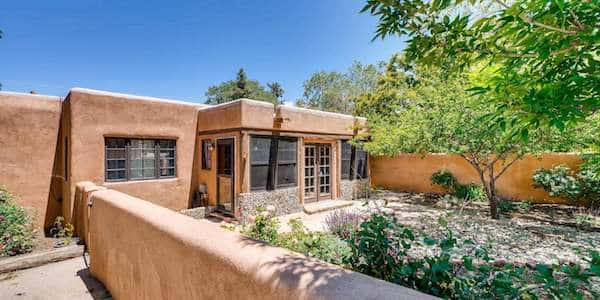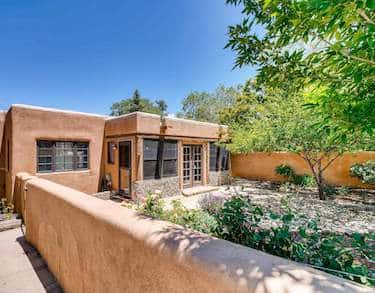
Trading up to a larger home in Santa Fe is a smart move in many ways. If you and your family live here now, you already know and appreciate our area. You know about the unparalleled recreational opportunities, the outdoor-oriented climate, the unique cultural offerings for families, and the authentic Southwestern cuisine.
If you’re considering moving to Santa Fe, no doubt you’ve done your research. And if you need help learning about The City Different, we’re a Santa Fe-grown real estate brokerage with deep roots in the community.
Plus, we’ve created resources for the Santa Fe homebuyer, like our Santa Fe New Resident’s Guide and our Millennial’s Guide to Santa Fe. For the trading-up homebuyer, we’ve created blog posts dedicated to the topic of buying a larger home. Scroll down for a list of links.
The process of finding and buying a larger home, however, involves multiple factors that can complicate the path to a successful real estate purchase. As with any home sale transaction, the more you know, the better prepared you’ll be to navigate the way ahead. These are seven mistakes to avoid as you trade up to a larger home in Santa Fe.
1. Not Tracking the Market
Real estate markets are local markets that change quickly. Tracking the market can help people detect trends, compare one market to another, and shed light on when might be the best time to list or start house hunting. One of the leading data points to know is current inventory. Another is the number of new listings on the market. Others include:
- The average asking price for new listings
- Average asking price per square foot
- Average days on the market
The numbers are only part of the picture, however. It’s important to know the ups and downs because the Santa Fe real estate market fluctuates constantly. Our Market Reports provide both for the savvy trading-up homebuyer.
2. Not Narrowing Down Where to Buy
When you’ve made the decision to buy a larger home, the door opens to a parade of incoming questions. One of the first is the question of where to buy. The answer can depend on a number of factors. These could include school location, the work commute, and access to essentials of everyday living (think hospitals and grocery stores).
Our property search tool makes it super simple to shop for homes in a geographic area you select. Use the “Draw Search” feature to draw your desired area and see available homes. Select the Schools icon to see where homes for sale are located relative to schools.
3. Not Developing a List of Home-Buying Criteria
You don’t have to be a Type A personality to know that going to the grocery store with a list makes for a more efficient and faster shopping experience. Developing a list of home-buying criteria achieves the same goal.
Your basic home-buying criteria will include standards such as number of bedrooms, number of bathrooms, total square feet of living space, lot size, and price range. But don’t stop there. Delve deeper and think about the type of home you want for growing family needs. These might include space for hobbies or an in-law suite. Parents with young children may want bedrooms located near the master bedroom. Families with teens may prefer a layout with kids’ bedrooms upstairs and a first-floor master suite.
Other criteria might include:
- A new construction home.
- A turn-key home that’s move-in ready.
- A home that needs some updates and repairs.
- A low-maintenance lot and exterior.
- A lot you can landscape and make your own.
- A location close to wilderness areas.
- A location closer to downtown Santa Fe.
You’ll notice that these particular criteria are in groupings that force an either/or choice. That’s deliberate. You should decide if you want to trade up to a new construction home, a turnkey home, or a fixer-upper home, for example. All three types of homes can be bigger than what you own now.
Need more help with this step? Use the checklist in our blog post Trading Up in Santa Fe: How to Think About Buying a Bigger Home.
4. Not Tapping into Your Agent’s Expertise
You may be a long-time resident, a recent arrival, or a Santa Fe transplant. No matter. Your Barker real estate agent is a source of expertise and information that will inform your home-buying journey. Early in the process, set up a time to meet with your agent and talk about your trading-up goals. Share your home-buying criteria. Let your agent know your preferred method of communication. In addition to helping you buy a larger home, your agent can help you find a range of resources from movers to contractors.
5. Not Getting Pre-Qualified and Pre-Approved for a Mortgage
According to Investopedia, both pre-qualification and pre-approval are key steps in the mortgage process. Although some people use the terms interchangeably, there are differences the home buyer should understand.
Pre-qualification is the first step in the mortgage process. Based on the information you provide, a lender will give you a ballpark estimate of how much you can borrow.
Pre-approval is a more formal process that requires the buyer to complete a mortgage application. This will include documentation that allows the lender to pull your credit report and pre-approve a mortgage for a specified amount and interest rate.
This article from The Balance outlines five advantage of getting pre-approved for a mortgage. All five benefit the home buyer. For the trading-up homebuyer, mortgage pre-approval helps you narrow the search to include homes you’re qualified to buy—giving you more time to examine the homes that fit your financial parameters.
6. Not Deciding Whether to Sell Your Home First
One major decision that comes with trading up to a larger home is whether to sell before you buy. In the world of real estate, this is known as the biggest Catch-22. The answer depends on multiple market factors and your own personal timeline. But both strategies have their advantages and disadvantages. Your real estate agent can help you make this decision by providing current market conditions—such as whether it’s a buyer’s market or a seller’s market. You can also do your own research using these resources:
From Kiplinger: Homeowners Must Decide Whether to Buy or Sell First
From Realtor.com, 5 Times It’s Smarter to Sell Your Old Home Before Buying a New One
From The Balance: Should You Buy First and Sell Second?
7. Not Coordinating Closings
Closings are complicated under any circumstances. Be sure to work closely with your agent to coordinate transactions that will involve loan officers, appraisers, home inspectors, lawyers, and title companies. It’s possible to close on two properties on the same day—but it requires advance preparation and scheduling as well as ongoing communication. Your Barker real estate agent will walk you through every step of the closing process, including outlining the documentation you’ll need to gather.

